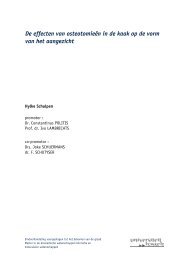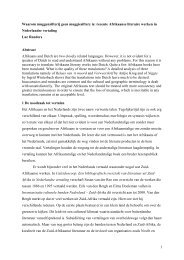Planning Problems in Intermodal Freight Transport ...
Planning Problems in Intermodal Freight Transport ...
Planning Problems in Intermodal Freight Transport ...
You also want an ePaper? Increase the reach of your titles
YUMPU automatically turns print PDFs into web optimized ePapers that Google loves.
configuration. Three future scenarios of land <strong>in</strong>frastructure are evaluated, assum<strong>in</strong>g a constant<br />
growth <strong>in</strong> sea traffic <strong>in</strong> the time period 2002-2012. The authors exam<strong>in</strong>e the degree of<br />
saturation of railway l<strong>in</strong>es and the level of congestion at truck gates. Klodz<strong>in</strong>ski and Al-Deek<br />
[23] develop a methodology for estimat<strong>in</strong>g the impact of an <strong>in</strong>termodal facility on a local road<br />
network. First, an artificial neural network model is used to generate truck trips from vessel<br />
freight data. Second, the generated truck volumes serve as an <strong>in</strong>put for a microscopic network<br />
simulation model. By do<strong>in</strong>g so critical l<strong>in</strong>ks <strong>in</strong> the road network can be identified. This<br />
methodology may also be used to evaluate local port networks to manage traffic efficiently<br />
dur<strong>in</strong>g heavy congestion or to <strong>in</strong>vestigate the impact of forecasted port growth on a road<br />
network.<br />
Locations for <strong>in</strong>termodal term<strong>in</strong>als may be determ<strong>in</strong>ed by means of network models.<br />
Arnold and Thomas [24] m<strong>in</strong>imise total transport costs <strong>in</strong> order to f<strong>in</strong>d optimal locations for<br />
<strong>in</strong>termodal rail/road term<strong>in</strong>als <strong>in</strong> Belgium by means of an <strong>in</strong>teger programm<strong>in</strong>g model.<br />
Groothedde and Tavasszy [25] m<strong>in</strong>imise generalised and external costs <strong>in</strong> order to f<strong>in</strong>d the<br />
optimal location of <strong>in</strong>termodal rail/road term<strong>in</strong>als. Simulated anneal<strong>in</strong>g is used to f<strong>in</strong>d near-<br />
optimal locations of term<strong>in</strong>als. Arnold et al. [26] propose an alternative formulation closely<br />
l<strong>in</strong>ked to multi-commodity fixed-charge network design problems. The result<strong>in</strong>g l<strong>in</strong>ear <strong>in</strong>teger<br />
program is solved heuristically. The model is illustrated for the location of rail/road term<strong>in</strong>als<br />
<strong>in</strong> the Iberian Pen<strong>in</strong>sula. In this application, the impact of variations <strong>in</strong> the supply of transport<br />
on modal shares of conta<strong>in</strong>erised freight transport is explored. Macharis [27] develops a GIS<br />
model to analyse the potential market area of new term<strong>in</strong>als and to analyse their effect on the<br />
market area of the exist<strong>in</strong>g ones. Rutten [28] <strong>in</strong>vestigates the <strong>in</strong>terrelationship between<br />
term<strong>in</strong>al locations, number of term<strong>in</strong>als, shuttle tra<strong>in</strong> length and system performance <strong>in</strong> an<br />
<strong>in</strong>termodal rail network. The author discusses the TERMINET model, which comprises a









